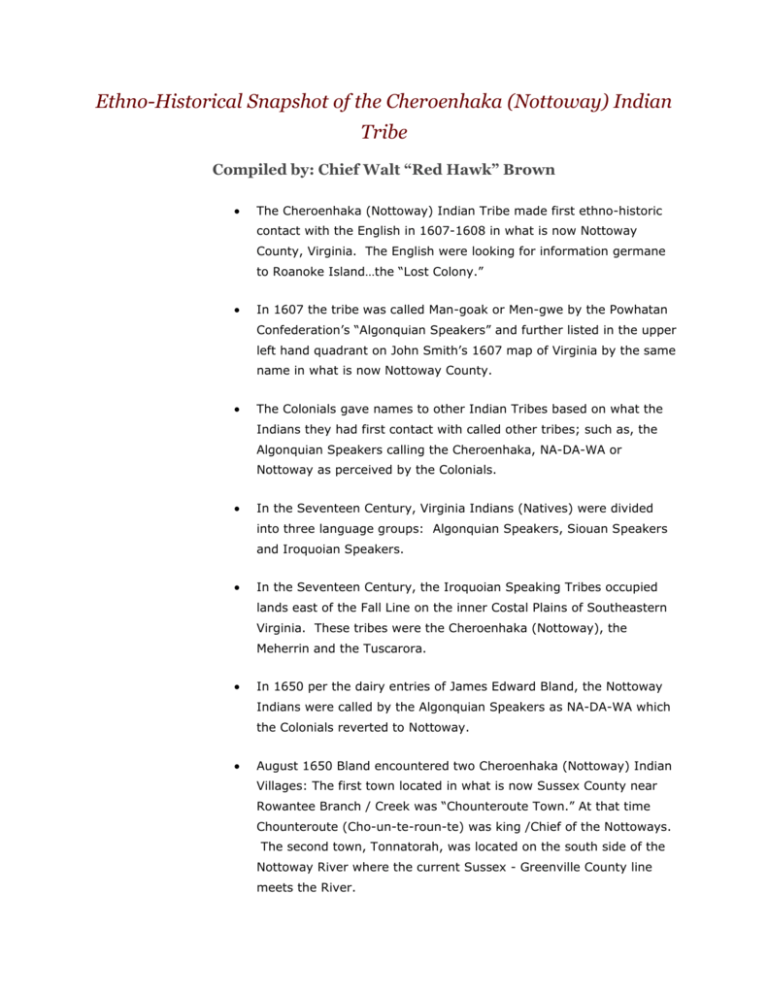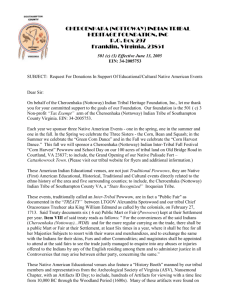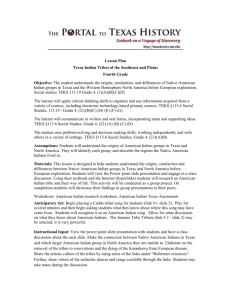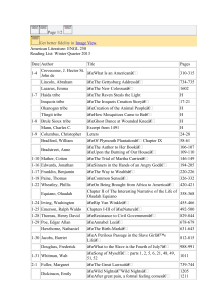EthnoHistoricalSnaps.. - Cheroenhaka (Nottoway)
advertisement

Ethno-Historical Snapshot of the Cheroenhaka (Nottoway) Indian Tribe Compiled by: Chief Walt “Red Hawk” Brown The Cheroenhaka (Nottoway) Indian Tribe made first ethno-historic contact with the English in 1607-1608 in what is now Nottoway County, Virginia. The English were looking for information germane to Roanoke Island…the “Lost Colony.” In 1607 the tribe was called Man-goak or Men-gwe by the Powhatan Confederation’s “Algonquian Speakers” and further listed in the upper left hand quadrant on John Smith’s 1607 map of Virginia by the same name in what is now Nottoway County. The Colonials gave names to other Indian Tribes based on what the Indians they had first contact with called other tribes; such as, the Algonquian Speakers calling the Cheroenhaka, NA-DA-WA or Nottoway as perceived by the Colonials. In the Seventeen Century, Virginia Indians (Natives) were divided into three language groups: Algonquian Speakers, Siouan Speakers and Iroquoian Speakers. In the Seventeen Century, the Iroquoian Speaking Tribes occupied lands east of the Fall Line on the inner Costal Plains of Southeastern Virginia. These tribes were the Cheroenhaka (Nottoway), the Meherrin and the Tuscarora. In 1650 per the dairy entries of James Edward Bland, the Nottoway Indians were called by the Algonquian Speakers as NA-DA-WA which the Colonials reverted to Nottoway. August 1650 Bland encountered two Cheroenhaka (Nottoway) Indian Villages: The first town located in what is now Sussex County near Rowantee Branch / Creek was “Chounteroute Town.” At that time Chounteroute (Cho-un-te-roun-te) was king /Chief of the Nottoways. The second town, Tonnatorah, was located on the south side of the Nottoway River where the current Sussex - Greenville County line meets the River. The true name of the tribe is Cheroenhaka (Che-ro-en-ha-ka), meaning “People at the Fork of the Steam.” The tribe’s lodging area was where the Nottoway River fork with The Backwater River to form the Chowan River – thus “People at the Fork of the Steam.” The Cheroenhaka (Nottoway) Indian Tribe signed three treaties: The Treaty of 1646; 1677 and a STAND ALONE Treaty of February 7th, 1713. On February 7, 1713 Colonial LT Gov. Spotswood signed a Stand Alone Treaty with the Cheroenhaka (Nottoway) Indian Tribe’s Chief “Ouracoorass Teerheer”, AKA William Edmund / Edmond, as called by the Colonials. Said Treaty has a “Successor Clause.” Our tribal government (Council) contends that the Successor Clause meant that the recognized relationship the tribe had with the Colonials from 1713 to1775 continued with the Commonwealth of Virginia beginning in 1776 to the present time. Tribal Warriors of the Cheroenhaka (Nottoway) Indian Tribe joined forces with Bacon in what became known as the infamous Nathaniel Bacon’s Rebellion of May 1776 resulting in the downfall of Occaneechee Island / Indians on the Roanoke River. In the mid 1680s, the Cheroenhaka (Nottoway) Indian Tribe, due to encroachment by the Colonials and to avoid war with other tribes, move from the Nottoway Town of Ta-ma-hit-ton / Tonnatorah in Sussex County to the mouth of the Assamoosick Swamp in what is now Surry County and again in the mid 1690s moved further down the Assamoosick toward present day Courtland and Sebrell in what was then Isle of Wight County - currently Southampton County Virginia. In 1705 the House of Burgess granted two tracks of land to the Cheroenhaka (Nottoway) Indian Tribe – the Circle and Square Tracks consisting of some 41,000 acres of Reservation Land. The tracks of land fell within the confines of what was then Isle of Wight County – now Southampton and Sussex Counties. Note: Southampton County was annexed from Isle of Wight County in 1749. In 1711 Colonial LT Governor Alexander Spotswood met with the Cheroenhaka offering “Tribute” forgiveness, reference in The Treaty of 1677, if the Cheroenhaka would send their sons to the “Brafferton,” a school for Indians at the College of William and Mary. Even though the Cheroenhaka were fearful their sons would be sold into slavery, ethno-historic records document that Spotswood reported on November 17, 1711 that two sons of the Cheroenhaka (Nottoway) Indian Chief’s men were attending the “Brafferton.” Cheroenhaka (Nottoway) Indians “Surnames” continue to appear on the enrollment roster of the “Brafferton” throughout the 1750s and 1760s. On August 7th, 1735, the Indian Interpreters, Henry Briggs and Thomas Wynn, for the Cheroenhaka (Nottoway) Indians were dismissed by an Act by the Commonwealth and on the same day the “first” of many land transfer deeds for the “Circle Tract of Land” transpired between the Colonials and the Cheroenhaka (Nottoway) Chief’s Men and would continue up until November 1953, until both Circle and Square Track of Lands (41, 000 Acres of Reservation Lands), were in the hands of the Europeans. In July of 1808 the Governor of the Commonwealth of Virginia mandated a “Special” Nottoway Indian Census be taken of those Indians living on the remaining lands of the Nottoway Indian Reservation in what is now Courtland, Virginia. – some 3, 000 + acres. The Special Census was conducted by “white” Tribal Trustees. They were Henry Blow, William Blow, (a descendant of John Blow) and Samuel Blunt. Note: Not all Cheroenhaka (Nottoway) Indian living on the Reservation were enumerated. In 1820 Former President Thomas Jefferson procured a copy of the language of the Cheroenhaka (Nottoway) Indians as recorded by John Wood. Wood recorded the language on March 4th, 1820, from Edie Turner, who lived on the tribe’s reservation in Southampton County, Virginia. Jefferson sent a copy of the language to Peter DuPonceau of Philadelphia who recognized the language as Iroquoian. On March 17, 1820, Jefferson was quoted in a article that appeared in the Petersburg Newspaper, that the only remains in the state of Virginia of the formidable tribes are the Pamunkeys and Nottoways [Cheroenhaka…WDB] and a few Mottoponies. According to Albert Gallatin (Gallatin 1836:82), The Honorable James Tresevant (Trezevant) compiled a second recording of the Cheroenhaka (Nottoway) Language in Southampton County, Virginia, between 1831 and 1836. Tresevant reports that the Nottoway name for themselves was Cheroenhaka, sometimes spelled Cherohakah. In 1823-24 William Bozeman AKA Billy Woodson (name listed on the Special Nottoway Indian Census of 1808, Note: Billy Woodson’s father was white – Michal Boseman), files petition with Court of Southampton County to have remaining Nottoway Indian Reservations Lands divided “Free and Simple” between the Nottoway Indians. On January 4th , 1849, 73rd year of the Commonwealth, the Cheroenhaka (Nottoway) Indian Tribe filled suite within the Commonwealth of Virginia Circuit Superior Court of Law and Chancery for the County of Southampton County against Jeremiah Cobb. The suite was filled on behalf of the Cheroenhaka (Nottoway) Indian Tribal Members and all other members of said tribe by the tribe’s Trustees (white), James W. Parker, G.N.W. Newsom, and Jesse S. Parham. On November 8th, 1850 Judge Rich H. Baker, Court of Southampton County ruled in favor of the Cheroenhaka (Nottoway) Indian Tribe and on March 3, 1851, witness by Littleton R. Edwards, Court Clerk, awarded $818.80 with interest from June 1, 1845. As a result of the successful Court Case in 1851, the Commonwealth of Virginia in the Circuit Superior Court of Law and Chancery for the County of Southampton County, Virginia RECOGNIZED the Cheroenhaka (Nottoway) Indian Tribe, Southampton County, as a Tribe and has never, since said time, by way of Law, Act, Bill or Policy negated its Tribal Status. In 1850s as the final bits of Reservation Lands was disappearing into the hands of the Europeans many Tribal members (Artist, Bozeman, Turners, Rogers, Brown) relocated to what became known a “Artist Town” near what is now Riverdale Road in Southampton County, Virginia. Their descendants continue to live there as a tribal communal group up until the late 1990s sharing their Native American Traditions and Customs – hunting, trapping, fishing the Nottoway River, farming, and raising hogs. Excavation of the Hand Site Settlement (44SN22), in Southampton County, Virginia, off hwy 671, in 1965, 66 and 69, wherein some 131 graves remains of Cheroenhaka (Nottoway) Indian Skeletal remains were removed and placed on a shelf at the Smithsonian National Museum of Natural History in Washington, DC. The Skeletal remains date back to 1580. The Cheroenhaka (Nottoway) Indian Tribe is the only “Iroquoian Tribe” still residing in the Commonwealth of Virginia claiming a documented continual existing “STATE RECOGNIZED” status. [Cheroenhaka (Nottoway) Indian Tribe Vs Jeremiah Cobb, March 3rd, 1851, Commonwealth of Virginia Circuit Superior Court of Law and Chancery for the County of Southampton County]. In February 2002, the Historic Cheroenhaka (Nottoway) Indian Tribe reorganized by bringing together family clusters of Cheroenhaka (Nottoway) Indian Descendants and families still living in Southampton County Virginia. In May 2002 a tribal government was in place with the election of a Chief and Council Members. The first Pow Wow and Gathering took place on July of the same year and has continued since on the fourth weekend of July each year as a celebration of the “Green Corn Harvest” (Ke-to-ok-ney). In September of 2002, Chief Walt “Red Hawk” Brown of the Cheroenhaka (Nottoway) Indian Tribe was invited into the Virginia Public School System and began giving Native American Presentations on Virginia Indian History, with special inferences on the ethno-history of the Cheroenhaka (Nottoway) Indian Tribe, Southampton County Virginia, to the student population, elementary and secondary, within schools throughout Southeastern Virginia and Hampton Roads. These speaking engagements have continued over the past five years within Public and Parochial Schools; to include, Historical Societies. On December 7, 2002 the Cheroenhaka (Nottoway) Indian Tribe filed a letter of intent with the Bureau of Indian Affairs (BIA) announcing that it would be filing for Federal Recognition. On July 29, 2003, the Court of Southampton County, Virginia issued a license to Chief Walter David “Red Hawk” Brown, III of the Cheroenhaka (Nottoway) Indian Tribe, with all rights to perform the rites of matrimony for said Cheroenhaka (Nottoway) Indian Tribe in accordance with the customs and traditions of said tribe. On February 27th 2004 the Cheroenhaka (Nottoway) Indian Tribal Shield and Heraldry was copyrighted with the Library of Congress. (VA 1-256-506). In July 2004 the first volume (Issue I ) of the Journal of the Cheroenhaka (Nottoway) Indian Tribe, the Waskehee (Was-ke-hee), was published and has continued each year thereafter. Issue II, “A Reflection of the Past,” highlighting the Cheroenhaka (Nottoway) Indian Tribe’s march/participation in the opening of the National Museum of American Indian, on September 21, 2004, in Washington, DC was published July 2005. Issue three, “A Celebration of EthnoHistory,” was published July 2006. It highlighted the invited visit of the Cheroenhaka (Nottoway) Indian Tribe to the Smithsonian Institute, National Museum of Natural History (NMNH) to view the “Hand Site Skeletal Remains,” card cataloged as Cheroenhaka (Nottoway) Indian Remains. Note: Waskehee means “to see” in the language (Da-sun-ke) of the Cheroenhaka (Nottoway) Indian Tribe. On October 14th 2005, the Cheroenhaka (Nottoway) Indian Tribe’s “Elected Officials” along with select tribal members, visited the Smithsonian National Museum of Natural History, Washington, DC, at the invite of Dr. Dorothy Lippert, Case Officer, Repatriation Programs, and viewed, in a special showing, of Cheroenhaka (Nottoway) Indian “Skeletal Remains” taken from the Hand Site Excavation. The skeletal remains date back to 1580. In July 24, 2004 the elected official governmental body of Southampton County Virginia, the Southampton County Board of Supervisors, issued under it seal, a Proclamation of Recognition of the Cheroenhaka (Nottoway) Indian Tribe proclaiming July 24 of said year as “Cheroenhaka Day.” On June 3, 2005, the State Recognized WACCAMAW Indian Tribe of South Carolina voted in favor of a Joint Resolution of the WACCAMAW Tribal Government, Resolution Number: Joint-HH-06-04-05-001, recognizing the sovereignty of the Cheroenhaka (Nottoway) Indian Tribe, Southampton County, Virginia as signed by the Honorable Chief Harold D. Hatcher. On June 13th 2005 the Cheroenhaka (Nottoway) Indian Tribal Heritage Foundation was Incorporated as the Non Profit entity of the Cheroenhaka (Nottoway) Indian Tribe. On December 15, 2006, the Internal Revenue Service, Department of the Treasury, granted by letter 501 ( c ) ( 3 ) status, exempt from Federal Income Tax, to the Cheroenhaka (Nottoway) Indian Tribal Heritage Foundation, P. O. Box 297, Franklin, VA 23851, with an effective date of exemption, June 13, 2005. All Contribution to the Cheroenhaka (Nottoway) Indian Tribal Heritage Foundation are deductible under section 170 of the code. On January 18, 2006 the Cheroenhaka (Nottoway) Indian Tribe submitted to the General Assembly of Virginia, Senate Joint Resolution (SJ) 152, Title: Extending State Recognition to the Cheroenhaka (Nottoway) Indian Tribe. On July 22nd and 23rd 2006 the Cheroenhaka (Nottoway) Indian Tribe celebrated its Fifth Annual Tribal Powwow and Gathering – a celebration of the “Green Corn Harvest” with some 3, 000 attendees. On April 26, 2006, Chief Walt “Red Hawk” Brown along with 17 participating communities and government representatives gathered at the Cape Henry Memorial at Fort Story Virginia, the site where the first three English ships landed 399 years ago, and signed Hampton Roads, “The Year of Regional Citizenship Proclamation.” On November 25, 2006, the Cheroenhaka (Nottoway) Indian Tribe held a Peake Belt and Pipe Ceremony on the grounds of the Southampton County Court House – on the banks of the Nottoway River. Governmental representatives (Board of Supervisors) from Nottoway, Sussex, Surry, Isle of Wight and Southampton Counties participated in the ceremony. The five counties have an Ethnohistoric relationship with the tribe. The sacred pipe was passed among all governmental officials, after which, Chief Walt “Red Hawk” Brown presented a Peake (Peace) Belt made of wampum shells to each county. Government Official from Nottoway, Sussex, Surry and Isle of Wight read and presented to the tribe a “Proclamation of Official Tribal Recognition” under their County Seal as signed by the Chairman of the Board of Supervisors. Five Counties in Southeastern Virginia have “Officially Recognized” the Cheroenhaka (Nottoway) Indian Tribe. The Cheroenhaka (Nottoway) Indian Tribe Six Annual Pow Wow and Gathering will take place on July 21st and 22nd 2007 at the Southampton County Fairgrounds, Courtland, Virginia where the Cheroenhaka (Nottoway) Indian Tribe will celebrate 427 years of documented Ethno-History (1580 to 2007). Chief Walter D. “Red Hawk” Brown, III, Cheroenhaka (Nottoway) Indian Tribe Southampton County, Virginia





